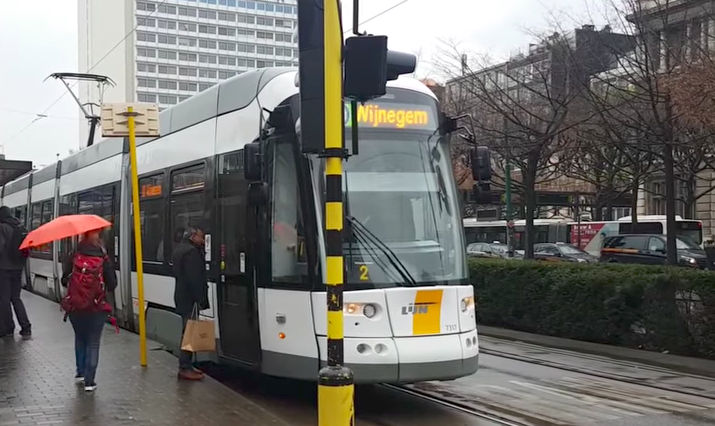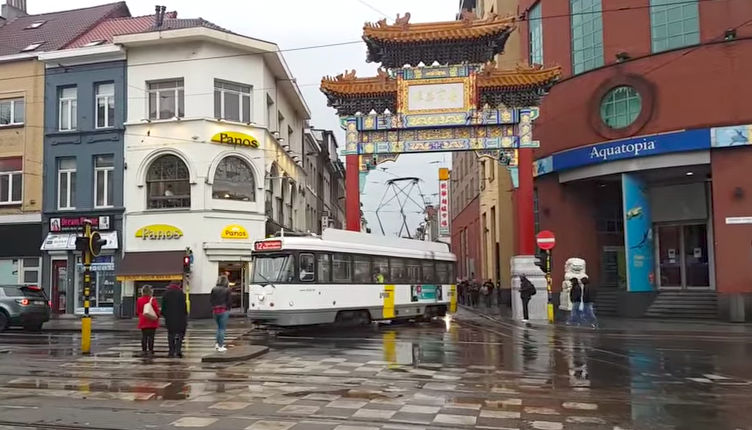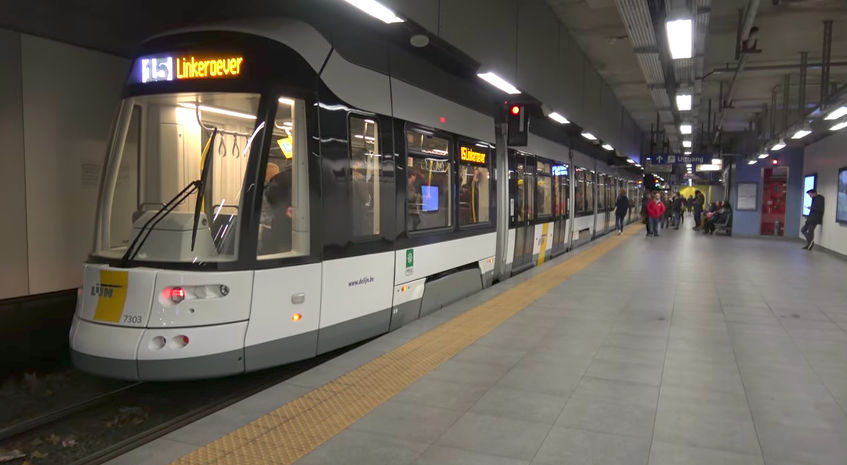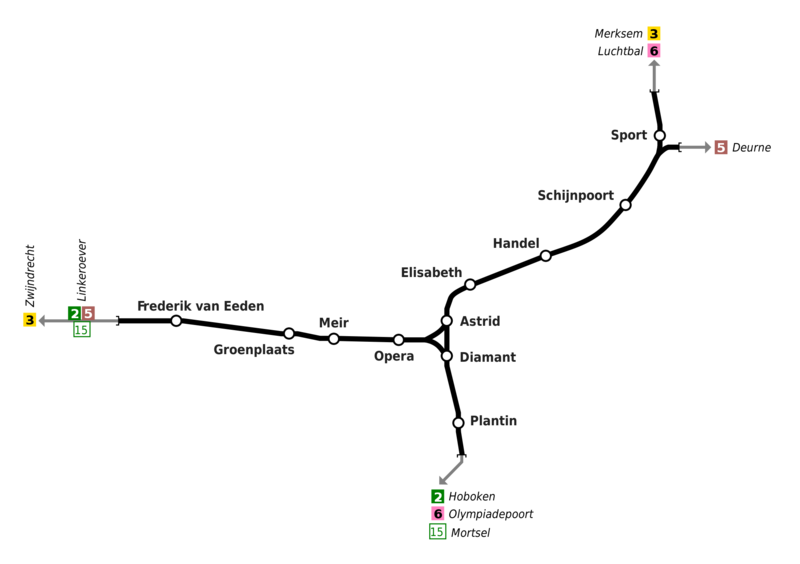The Antwerp Metro is not a regular metro system, it’s a network of underground tunnels where tramway lines circulate. It has a total distance of 13.5 km that serves 19 stations. Only 11 of them are operational, and only 11.2 km of the route are open to the public.
The price of a single ticket is 3 euros. The Antwerp Metro works everyday of the week from 4:30am to 1:00 am of the next day. The frecuency of the tramway in a rush hour is about 5 minutes and 15 minutes in a regular schedule.
Metros in Belgium: Antwerp Metro
Antwerp is located in Belgium and it’s the second most populated city in the European nation, with 1.200.000 residents in the metropolitan area. This city can be found behind Brussels, the capital of the country, in the northern region, specifically in Flandes, where the culture and language is different from the southern region, Valonia.
During the XX century the metropolis was affected by the inclemencies of the second world war, being occupied by the Nazis from 1940 to 1944. However, with the end of the war, the amberian people were able to rebuild their spaces to transform them in the richest areas of Belgium.
So then, with the economic development that was experimented by the territory in the 60’s, 70’s and 80’s, Antwerp significantly modernized their urban furniture, in which it stands out their traditional tramway system.
The metro
With the intentions to attend the demand of transportation, and with the sights on the future, the local authorities put into operation the development of the Antwerp Metro, even though this never happened.
In 1975 the first sections of the planned underground system were inaugurated, but not with the purpose of using metro trains in tunnels. Instead of that, the underground rails were used as a way of expansion for the tramways, that’s why the Antwerp Metro was baptized as “Premetro”.
Currently, it has 13.5 kilometers and 11 operative stations, in which the tramway lines 1,2,3,5,6,8,9,10 and 15 circulates.
Lines and stations
Line 2
This line connects the Hoboken district, in the south of the city, to the town of Merksem, in the north. It has a total length of 14.3 kilometers and 32 stations, and only 7 of them go through the underground grid of the Antwerp Metro. It’s one of the oldest routes of the city, mobilizing more than 10 million users with their vehicles annually. It’s identified on the maps of the service by having the number 2 on a dark green background. Likewise, the stops that make their way through the “Premetro” are: Plantin, Diamant, Astrid, Elisabeth, Handel, Schijnpoort and Sport.

Line 3
This route links the Merksem district, that is located in the north of Antwerp, to the Melsele neighborhood to the west. It has 14.37 kilometers distributed in 26 stations, 8 of these are located in the network of underground tunnels. Line 2 is one of the oldest routes, dating back to 1902. Transports nearly 30 million passengers each year. It can be identified in the maps of the system by having a 3 on a dark yellow background. The 8 underground stations of the line 3 are: Sport, Schijnpoort, Handel, Elisabeth, Astrid, Meir, Groenplaats and Van Eeden.
Line 6
This route connects Olympiade district that is at the south of the flemish city to the Luchtbal area at north. It has 13 kilometers of total route, which are distributed in 26 commercial stations. Only 7 stops are underground, integrating the Premetro. Dates from 1938. Transports nearly 6 million passengers each year. The passengers can identify the line in the maps for having a number 6 on a shiny fuchsia background. The 7 underground stations are: Sport, Schijnpoort, Handel, Elisabeth, Astrid, Diamant and Plantin.
Line 8
This line connects the Wommelgem town located in the north of the city with the Zuid district in the south of the city. It has 9 kilometers of total route, serving it’s 16 operational stations. Only two of the stations are underground. It’s a fairly recent line compared to other similar lines, since it dates back to 1988. Transports 750.000 passengers each year. The passengers can identify this line in the map for having a number 8 on a pink background. The underground stops are: Zegel and Astrid.
Line 9
It links the town of Eksterlaar in the west to the Linkeroever sector in the east. It has 9.28 kilometers, which pass through 18 stations. Of that 18 stations, 5 belongs to the Antwerp Metro or Premetro. Similar to route 8, line 9 is of early construction, being the year 1988 when it came into operation, to mobilize currently more than 10 million passengers annually. The passengers can identify this line in the map for having a number 9 on a orange background. The 5 underground stations are: Plantin, Diamant, Meir, Groenplaats and Van Eeden.
Line 10
It connects the Wijnegem district in the west of the Flemish city with Schoonselhof, a district located in the south of the polis. It has 14.5 kilometers, including a total of 32 stations. Of this total, only 2 transit the Premetro. It is one of the oldest tram routes in the metropolis, dating from 1873. Today it moves about 6 million passengers a year. It can be identified by having a number 10 on a light green background. The two underground stops are Zegel and Astrid.
Line 15
Thais route was designed to link the Boechout sector south-east of Antwerp to the town of Linkeroever in the west. It has 14.2 kilometers of route, including 27 stations, 5 of which are underground. It transports a large number of passengers, specifically 20 million. It’s identified by a green number 15 on a white background. The 5 stops belonging to the Premetro system are: Plantin, Diamant, Meir, Groenplaats and Van Eeden.

Connections
As it is a tunnel system that interconnects several tram lines, the Antwerp Metro has several connections to different routes in each of its 11 commercial stations. The following are the options available to Premetro users:
- Plantin Premetro Station: It is a small station comprising three levels, where you can find the area to purchase tickets and platforms. Here, subway passengers will have access to lines 2,6,9 and 15 of the city's tramways.
- Diamant Premetro Station: Diamant Station is built on four levels, between the tickets area and platforms. Passengers arriving at this metro stop can board lines 2,6,9 and 15 of the city's tramways.
- Astrid Premetro Station: Like the Diamant station, this station also features 4 levels for users' comfort. Visitors and residents of Antwerp can board tram routes 2,3,5,6,8 and 10.
- Elisabeth Premetro Station: This station has two levels, the upper one for ticket purchase and the lower one, where the platforms are located. At these facilities, users can take any of the following commercial tram lines: 2,3,5 and 6.
- Handel Premetro Station: This station has two levels, in addition to a single island platform. All travellers who come to this stop have at their disposal the number 2,3,5 and 6 tram lines that run through the entire flemish capital.
- Schijnpoort Premetro Station: Like the previous one, it presents three levels in total, between tickets and platforms. Tram routes 2,3,5 and 6 run along the latter.
- Sport Premetro Station: It also has three levels in total, being relatively small. Tramways 2,3 and 6 run along its platforms, which cover a large part of the city.
- egel Premetro Station: It is a small station with two levels, one for ticket sales and the other for the platforms. Only tram lines 8 and 10 run on it.
- Meir Premetro Station: It's a small two-level station. Lines 3,5,9 and 15 of the various tramways serving Antwerp run through its platforms.
- Groenplaats Premetro Station: This station has three commercial levels and serves tram lines number 3,5,9 and 15, similar to Meir Station.
- Van Eeden Premetro Station: This stop has only two levels, one for tickets and the other for platforms. In its facilities, users will be able to take advantage of routes 3,5,9 and 15 of the tramways that run the city.
Fares
The Antwerp Metro has different plans to make it easier for users to use the system. From the classic tickets to cards with special plans adapted to the passenger's requirements. Following, plans and forms of payment in the city's trams:
- Single ticket: With this ticket you can travel on tram lines for 60 minutes without limits. In other words, you will be able to make all the transfers necessary to reach your destination in that period of time. The price of this ticket is 3 euros.
- SMS ticket: In order to make your ticket purchase faster, you have the possibility to pay by text message. Once the corresponding fare has been paid, you will be able to use all the facilities of the Antwerp Metro for 60 minutes without any transfer or station limits. The price for this modality is 2 euros.
- Lijn card: With this card you can pay for several journeys of 60 minutes with a considerable reduction in the final price. It can be recharged for up to 15 1-hour sections, each with a value of 1.5 euros, which is 50% discount compared to the Single ticket.
- Day pass: This option allows users to travel on trains for an entire day, further subdivided into 3 and 5-day plans and accompanied by a special mode for children aged 6 to 11. The price for a full day ticket is 8 euros , the price for a 3-day ticket is 12 euros, the price for a 5-day ticket is 17 euros and, finally, the variant for children costs 5 euros.
- Group ticket (+ 5 people): This special package is only available for groups of at least 5 people and up to 44 people. It’is a very attractive option for academic excursions or executive events, with the price of a 60-minute ticket at 1.25 euros.
- Buzzy Pazz: Thanks to this special pass, young people from 6 to 24 years old have the possibility to pay for travel plans with a long duration, ranging from 1 to 12 months, with their respective prices. The one-month modality can be paid for 31 euros, it’s 3-month version is quoted at 77 euros, while the option for 12 months is at 204 euros.
- Omnipas: This pass is specially designed for people aged 25 and over, and its benefit is to be able to pay for extended periods of time without worrying about the expiration of it. This pass has three modalities that are 1 month for 47 euros, 3 months for 117 euros and 12 months for 306 euros.
- Omnipas 65+: This pass is exclusive for seniors over 65 years of age. It has a single modality of 12 months with unlimited travel, for only 52 euros.
Children under 6 years of age travel completely free of charge on the Antwerp Metro system.
Soldiers injured in combat will not pay any fees for using tramway services.
People with disabilities also have the benefit of travelling free of charge through the different stations and trains in the system.
Schedules
The tramway network is open from 4:30 am to 1:00 am the following day. A very convenient schedule for those who work at night, or whose work requires their presence early in the morning.
There is no distinction between public holidays and normal days, including weekends. The schedule for trains is always the same from Monday to Sunday. The vehicles service the stations with a frequency of 10-15 minutes, although the number of trams increases according to the demand at peak times, reducing the waiting time to just 5 minutes.

Rules
Like all public transport systems worldwide, the Antwerp Metro has a series of rules to guarantee the proper functioning of the system, as well as the best possible coexistence between passengers. Here are the Premetro rules:
- To ensure user’s safety, system personnel recommends a prudent distance from the yellow stripe before boarding the trains.
- No passenger is allowed to carry flammable elements, whether chemical, pyrotechnic sets or other similar items.
- Use of alcoholic beverages or other illegal substances is prohibited within the Antwerp Metro facilities.
- For safety reasons, users are prohibited from running inside the system's stations and trains, to avoid injuries that may include the running subject or a third party being pushed.
- Music playback is permitted only with the use of headphones, as sound may disturb other travelers.
- Accessing trams with baby strollers is allowed, as long as they are folded or placed in order not to hinder the movement of other passengers.
- The Antwerp Metro authorities do not allow the placement of pamphlets or posters that have not been submitted for consideration as they require prior authorization.
- Regular users of the system cannot carry firearms, the only exception will be law enforcement authorities.
- You may not smoke in stations or tramways of the Antwerp Metro.
Airport connections
There is no direct connection between the Antwerp-Deurne Airport and the city's tramway system. However, it’s possible to take one of its operational lines, make a transfer and travel to the air terminal. To do this, simply follow the instructions below:
First, take the tram line 9 in the direction of Eksterlaar until you reach Berchem Groenenhoek station. If you leave from the Mier station, the journey only takes about 15 minutes. When you reach your destination, you will have to get off the tram to walk about 200 meters to the bus stop with the same name as the tram station. There you can wait for any of the 51,52 or 53 bus routes, which go to the airport. After about 6 minutes you should be at your destination. The bus stop to get off at is called Deurne Luchthaven, located 100 meters from the air terminal.
Similarly, if your goal is to head to the city center from Antwerp-Deurne Airport, the route is similar. When you are in the air terminal, you will have to leave the premises, walk 100 meters to the Deurne Luchthaven bus stop, where you will have to wait for route 51 52, or 53, which will take you a few steps from the Berchem Groenenhoek tramway station, where line 9 runs. In turn, this train route will connect you to the entire city, as public transport in Antwerp is highly interconnected.
Tourist places
Sportpaleis is a multi-purpose complex where concerts, sporting events, festivals and fairs are held. Although the enclosure was originally built to house only events related to the world of sport, today it is presented as a place full of diverse celebrations throughout the year. It dates from 1933. Billboard magazine considers it the second most visited space for organizing events in the world, second only to Madison Square Garden in New York (USA). It has a roof covering 11,600 m2, which has witnessed important concerts, performed by renowned personalities such as Beyoncé, Britney Spears or Lady Gaga.
Next to the Groenplaats station, walking a couple of blocks, is the majestic Plantin-Moretus Museum, a heritage treasure of Antwerp. The building had its origins as a printing press in the sixteenth century, belonging to the publisher and bookseller Cristóbal Plantino. In 1876, it became a museum open to the general public, and later became an UNESCO World Heritage Site in 2005. Inside it has unpublished works, among which the 36-line Gutenberg Bible and famous books by scholar Justo Lipsio stand out.
Metro map of Antwerp
Map via upload.wikimedia.orgSee map full resolution. It may take a little bit to load.
Antwerp Premetro map
- Also Known As: Premetro
- Passengers/Day
- Fares: honour system
- 24h operation: No
- Air Conditioning: No
- Walk between platforms: No
- Driverless trains: No
- Screen Doors Platforms: No
- € 2
- Antwerp Metro Official Website
Help us
If you consider that the information we provide is wrong, not accurated, outdated, translation contains errors, and you would like to help us to improve the file...you can contact us here.
Feel free to contact us if you dont find the system you're looking for and we'll add it as soon as we can!
Thank you very much!









